Sony Pictures Animation delivers a delicious, second helping with its 3-D CG sequel, Cloudy with a Chance of Meatballs 2.
This back-to-school season, kids may be treading through the cafeteria carefully after taking in a new animated adventure in which food bites back. Directed by Cody Cameron and Kris Peam, who were story artists on the first movie, Sony’s Cloudy with a Chance of Meatballs 2 brings back the hilarious characters based on the 2009 hit for another, colorful, gourmet go-round in stereoscopic CG.
The film’s sequel takes a vast departure from the original source material (the illustrated book by Judi and Ron Barrett) using an original story penned by John Francis Daley, Jonathan Goldstein and Erica Rivinoja. Following the delicious disaster created by Flynt’s (Bill Hader) food-making machine, the townsfolk abandon the island of Swallow Falls. On the mainland, Flynt is recruited by his science idol Chester V (Will Forte) to work at the incredible Live Corp Company, which has been tasked with cleaning up the mess. Together with Sam (Anna Faris), Brent (Andy Samberg), Manny (Benjamin Bratt), Officer Earl (Terry Crews), his dad Tim (James Caan) and faithful monkey Steve (Neil Patrick Harris), Flynt returns home to find the machine has been churning out hybrid “foodimals”–some cute and cuddly, some a bit more piquant. Kristen Schaal also stars as Chester V’s lipstick wearing orangutan, Barb.
Cameron, who also directed Sony’s Open Season 3, and Pearn, who was in the U.K. working on Arthur Christmas when the Cloudy 2 claxon rang, reveal that the idea evolved from a dropped story concept from the first film, which involved a volcano spitting out food creatures off shore, which was actually an orifice attached to a giant food monster.
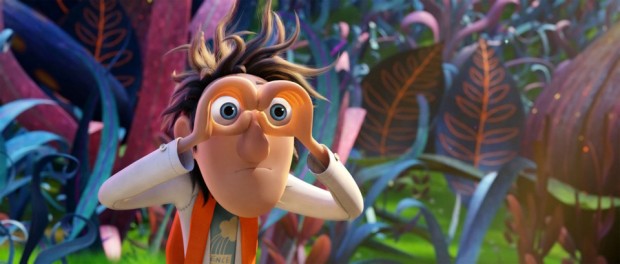
“At the end of the day, we moved closer to the ‘noble savage’ concept than a monster movie,” Pearn notes.
The directors drew on their favorite ’80s adventure flicks, primarily Steven Spielberg and George Lucas films–Predator, E.T. and notably Jurassic Park–to create the sequel’s epic, journey-film scope.
Pearn points out they also referred back to high school dramas about outsiders from the era, like Teen Wolf and Can’t Buy Me Love, for Flynt’s story.
“In the first movie we dealt with an outsider in a small town, and in this one we wanted to take him to a world where he wasn’t the outsider–how do you hang on to your values when you go on to that part of your life?” Back to the Future and Real Genius threw some sci-fi hilarity into the twosome’s stew of influences.

Play with Your Food!
The Cloudy universe’s creative silliness shines in the island’s menagerie of foodimals–creatures inspired by portmanteaux of animals and edibles like shrimpanzees, watermelophants, wildebeets and apple pie-thons. There are also simpler critters: oversized, anthropomorphic pickles, leeks, a downcast tomato and the humans’ adorable “tourguide,” Barry the strawberry (voiced by Cameron).
The directors originally conceived the foodimals as belonging to “sweet” and “savory” tribes. With that in mind, they tapped accomplished character designer Craig Kellman (Monsters vs. Aliens) to start exploring the possibilities.
“The directors just asked him, why don’t you go away and just try to think of some food puns,” says production designer Justin Thompson. “A week later he came back with 160 of them. All these amazing little drawings–we had to pick and choose, there were so many!”
The design team’s priority was to make each foodimal as cute as possible to get audiences to feel attached to and invested in them. Of course, every adventure movie needs a couple terrifying beasts stalking through the jungle. The most dangerous foodimals (and the directors’ favorites) are the snapping tacodile and Alien-esque cheese-spider, a giant cheeseburger with eight legs and a bad attitude.
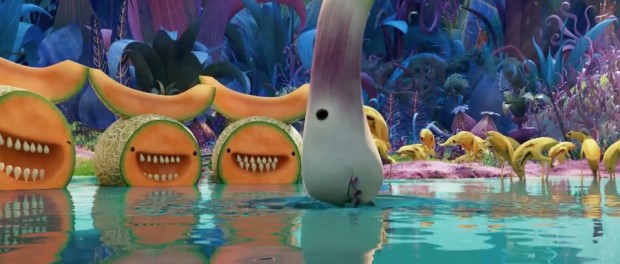
“Those characters were so funny in their design that we realized the best way to animate the big ones, like the tacodile, cheese-spider and wild scallions, was to treat it like a vfx movie,” says supervising animator Pete Nash. “We said, let’s pretend we’re animating a dinosaur, or Godzilla, and make the weight believable and make this thing kind of menacing–you take one look at it and of course this thing isn’t menacing, but it’s moving like it is. With the cheese-spider, sometimes it would move like a creature in a monster movie, at other times it would have the speed and agility of a spider–it could make a really quick move and surprise you.”
The foodified world of Swallow Falls is so teeming with life, from the majestic unicorn to the less majestic hotdog, audiences may miss one if the island’s more elusive critters: the legendary Sasquash.
“He’s like an Easter Egg, as you’re watching the movie, he pops up a lot,” Pearn lets on. Cameron adds, “We thought about making it a contest, who could spot every time the Sasquash appears.”
Vfx supervisor Pete Travers tells us that as a fun side project (and to familiarize himself with the new pipeline), he personally modeled and rigged the mythical gourd.
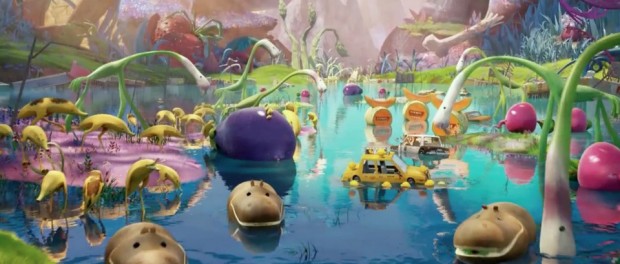
Epicurean Evolutions
While the core group of characters were established by the first film, the directors made it a priority to show how they have evolved since leaving the island. Flynt, as the film’s hero, provides the emotional core of the film, both in the way he reacts to no longer being a big scientific fish in a small-town pond after joining Live Corp and in his relationships with the others.
Since the first outing, the predominantly silent Manny has been revealed to be a doctor as well as a pilot, Earl has gotten a chance to really use his super-cop powers, Sam has embraced her nerdiness and Brent has become more chicken than man, and the filmmakers wanted to explore all these character avenues–especially Flynt’s relationship with his dad, Tim.
“We definitely wanted to continue the father-son story, which was the emotional core of the first film,” says Pearn. “Now, [Flynt] is kind of going through this ‘adolescence’ and his dad hugging him is getting annoying. Tim is a big guy with big, meaty hands and it kind of hurts.”
So, as Flynt pulls away, his pop tries to fill the gap.
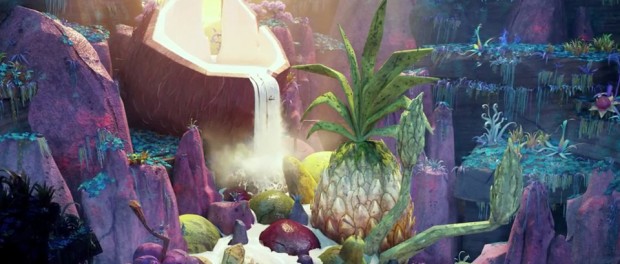
“Tim was the only character in the first film who loved sardines,” adds Cameron. “And [in Cloudy 2] he comes across these pickles that love sardines, so he has this kinship with the pickles.”
In addition to the character’s personal developments, the Sony team also ramped up their animation pipeline with a new character rigging system—which was key given the production’s tight timeline of less than a year, following just two and a half years of story development.
“On the first movie, the old rig we had was kind of an archaic system,” the animation supe admits. “The problem with Cloudy is that the characters have to go through such a wide range of facial expressions. Flynt can have the tiniest mouth, it’s almost a dot, so we need to be able to make this tiny little mouth but also need to be able to make it enormous, like a big screaming cartoon face. To do that, there’s literally thousands of controls on the face.”
Nash explains that the old system required artists to search through incredibly long lists of controls in order to manipulate a facial rig. For the sequel, the animators were blessed with an updated system that applied controls directly to the facial geometry, enabling them to basically grab and drag the control points to create expressions. This eased the way for the artists to capture the “Tex Avery Bugs Bunny Muppet-fest” feel Thompson and his designers aimed for.
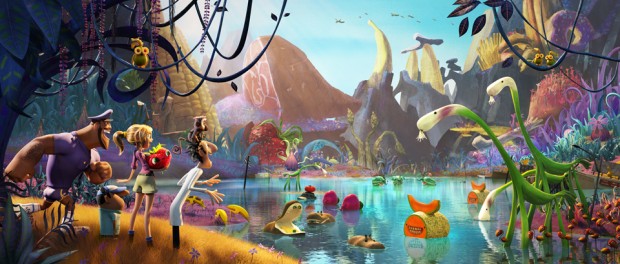
Another big leap forward came as an innovative new approach to crowd animation. Previously, the studio used Massive for crowd scenes, but did away with the program for this film and absorbed all crowd animation into the animation department, which while a challenge for the team was also a big cost savings. The department developed a new program that allowed them to organize groups of characters, take away their rig and leave a 3D “shell” in the scene. These lighter to render shells allowed for highly complex animation within scenes with hundreds of extras. The crew came up with elaborate batches of cycles and design variables which lend visual richness to large scenes, especially those set at Live Corp.
Journey to the Center of the Buffet
Every good epic journey movie needs awe-inspiring locations to set off the action. When you’re in the Cloudy world, this means rich (and sweet … and salty … and often sticky) environments sculpted out of avalanches of foodstuffs.
“We started by thinking, and it sounds corny, what would be really good wish fulfillment for kids?” Thompson explains. “We didn’t want to repeat too much from the first film, and we didn’t want to do anything too ‘Candyland.'”
The results of the design team’s efforts include a spaghetti and meatballs landscape, mashed potatoes and gravy falls and a mountain-scaling mission up a mutli-colored, translucent rock candy crag. One sequence Travers and his fx team were wowed by is the trek through the “Breakfast Bog”—a marshy area sopping with syrup oozing through waffle trees, pancakes and donuts.

Travers explains that the environments represent a majority of the R&D efforts for the film, and physics-based simulations like the fluids with various properties feature heavily.
“The maple syrup in the Breakfast Bog, the sequence where they’re travelling down the river, there’s a coconut waterfall, strawberry jam, stuff flying off of a taco … it’s everywhere.”
Both Travers and Thompson consider the big reveal scene, called “Sardine Circle” by the production teams, the most awe-inducing sequence. Which is good, since it sets the tone for the edible adventure to come. “Every single shot was a brand new environment,” says Travers.
“We built everything shot-by-shot to show the richness of the world … the colors are so vibrant, and we really punched up that strong stylization.”

“That first sequence, when you first see all the creatures, we probably had to rebuild the environment four times and lay out the set a couple different ways, positioning all the animals, where we had the lighting … it took about nine months, but it paid off,” adds Thompson.
The vfx and design teams, with artists and supervisors split between Sony’s L.A. and Vancouver studios, also got to play around with bioluminescence–a glow produced by living organisms (including sea creatures, insects, bacteria and fungi)–by imbuing certain plants with it to lend an ethereal quality to the jungle shadows. And in keeping with the cartoony stylization of the world, the artists really upped the color factor wherever they could.
“We have broken the record for most-saturated movie ever,” Travers assures. “I don’t know if Guinness is tracking that, but we definitely broke it.”
With the variety of foodimals and the lush edible landscapes they inhabit, the average moviegoer would be excused for not noticing one of the coolest tech tricks employed for Cloudy 2. The production crew dubbed it “Depth Styling,” and it allowed the filmmakers to seamlessly blend CG elements into the more illustrative backgrounds within the stereoscopic animation. The fx crew developed ways of stacking renders, changing the model as the camera moves through a shot. Basically, as a render moves toward the background, it is being rendered the same way, but the lighting model is being gradually altered, stripped away, so that by the time the render backs up into the matte painting, it blends right in.

“Early on in visual development, Pete Travers and I were talking, looking at the artwork. He looks at me and goes, ‘Hey, would you want the movie to actually look like this?'” Thompson recalls. “The first couple of tests I saw, I stood up and clapped.”
The Depth Styling system lets objects keep their texture as it moves through Z space and does away with the old tricks of blurring or atmospherics to defer the eye’s attention.
For the directors, the biggest challenges and accomplishments all boil down to the story and the relatability of the characters. On top of the logistics of wrangling roughly 500 crew members (a larger group than worked on the first film), including 80 to 100 animators, on a very tight schedule and coordinating the L.A. and Vancouver teams, Cameron and Pearn had to find ways to open up the Cloudy universe while staying true to what made the first film a success.
“Story is always the hardest part, being fresh about stuff you’ve been working on for two years,” Pearn notes. “You have to stay fresh and stay true to the vision, while at the same time being loose enough to bend with the wind and make things better. Staying firm when you need to be firm, and being flexible.”
Sony serves up Cloudy with a Chance of Meatballs 2 in theaters September 27.




 Win a Funko X Lilo & Stitch Prize Pack!
Win a Funko X Lilo & Stitch Prize Pack! 
